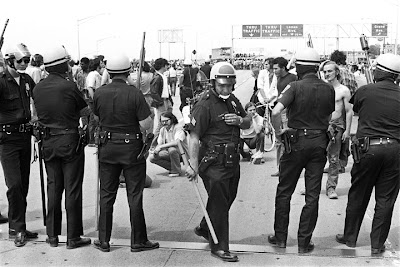What’s Wrong With This Picture?

Former Albuquerque Police Chief Donald A. Byrd, who served from 1971 to 1973, died February 5, 2012 on his ranch in Hughes County Okla. He was 84.
According to his obituary in the Dallas Morning News.
Byrd joined the Dallas Police Department and served 20 years, rising to the rank of deputy chief, when then he came to Albuquerque. He returned to Dallas where served as Chief until retiring in 1979. He became Dallas County Sheriff and served a four-year term, from 1981 to 1984.

Don Byrd is not remembered by many police officers today, and even 17 years ago a sergeant, writing a brief history of the APD skipped over Byrd. I wrote the following piece for the Albuquerque Police Officers’ association Newsletter, APOA Review.
My observations then still seem valid today.
The top and bottom photographs accompanied the article, while the others here, represent events during Byrd's time in Albuquerque.

So, What’s Wrong With This Picture?
Don Byrd is not remembered by many police officers today, and even 17 years ago a sergeant, writing a brief history of the APD skipped over Byrd. I wrote the following piece for the Albuquerque Police Officers’ association Newsletter, APOA Review.
My observations then still seem valid today.
The top and bottom photographs accompanied the article, while the others here, represent events during Byrd's time in Albuquerque.
The Missing Chief
Police Chief Donald A. Byrd
Sgt. Ken Dusenberry wrote a historical retrospective (March '95 APOA Review) on the Police Department starting in the early 1970's. He presented some interesting thoughts but, was factually incorrect. Paul A. Shaver was Chief of Police from 1948 till he retired in 1971, after going on sick leave in 1970. An interim Chief, Police Legal Advisor John Duffy was placed in charge temporarily during a national search for a new Chief.
The Department was racked with problems that surfaced in public. Two Deputy Chiefs were demoted in a scandal over the running of Montessa Park Jail (the discipline was later overturned), two officers were banned by a Municipal Court Judge from testifying in his court and labor activity among City workers was heating up as Blue Collar workers went on strike and clashed with officers when they tried to close down the Pino yards.
Dallas Deputy Chief of Police Donald A. Byrd took over the Department just days before a major riot started at Roosevelt Park in early summer of 1971. The riot was real, Dusenberry is correct when he speaks about burning police cars and injured citizens and officers. (I was beaten and had my cameras stolen by a crowd of 50 to 100 rioters when I tried to photograph the burning of an overturned police car.)
Chief Byrd instituted what we would today call "community based policing." He asked all officers to join civic organizations to get closer to everyday citizens. The standard for taking police reports was tightened - every contact with any citizen required a written report. The result was that Albuquerque's crime rate drastically rose to number one in the nation for two years. At the time there was a lot of federal funding available under the Omnibus Crime Bill of the Nixon administration. With the number one crime rate, Albuquerque was able to capitalize on funding and the number of officers increased to around 450.
Several new ideas were instituted, like the DWI unit with video taping of field sobriety testing and the purchase of new equipment including shotguns for every marked unit. The crime rate decreased when the reporting protocol was relaxed. It was a political masterstroke that had a positive effect on our Department.
Byrd returned to Dallas as their Chief of Police in 1973 after hand picking recently promoted Lt. Bob Stover who headed the newly formed Internal Affairs unit as his successor. To ignore Byrd's contributions to the Albuquerque Police Department leads us to misperceive where we are today.








No comments:
Post a Comment